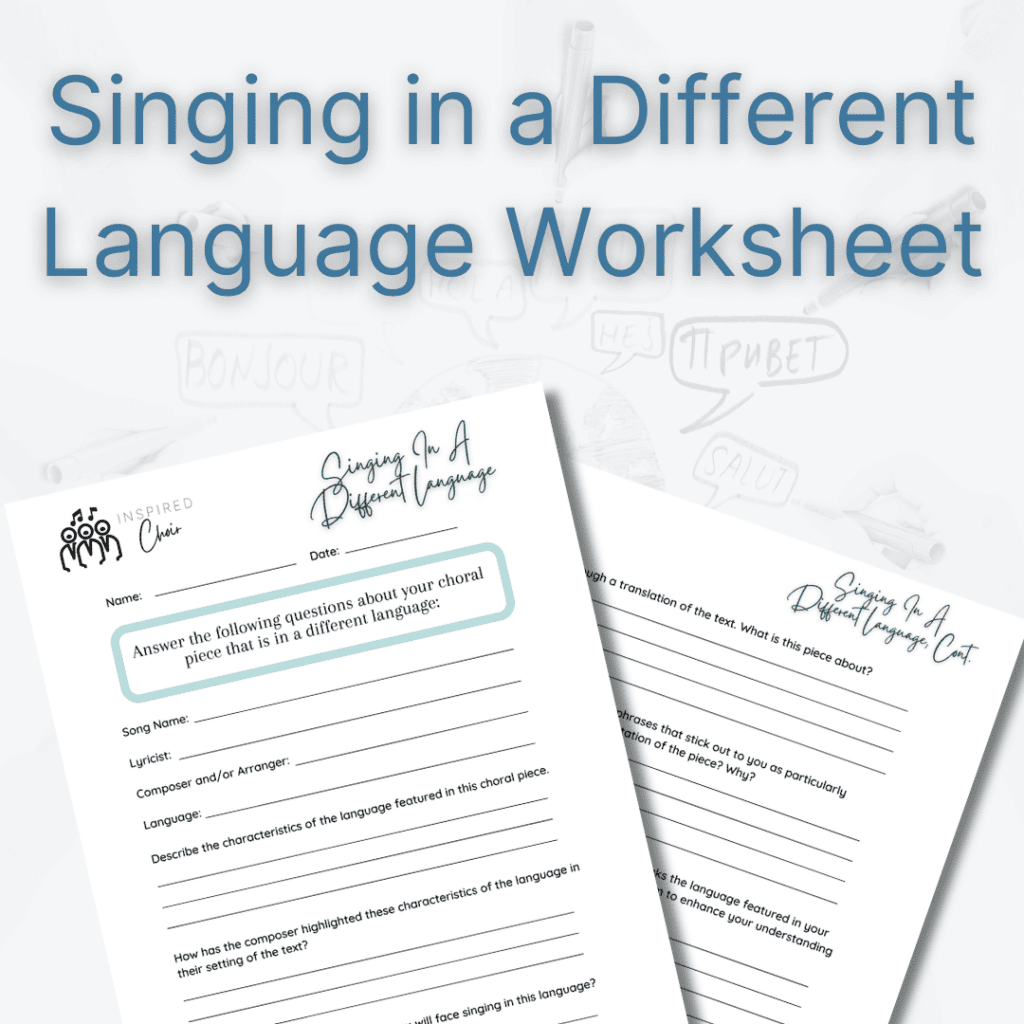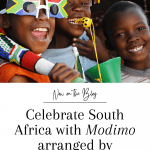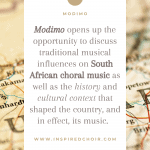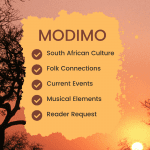Celebrate South Africa with Modimo arranged by Michael Barrett
This post marks Inspired Choir’s first ever Reader Request Post! Modimo arranged by Michael Barrett is a celebration of traditional South African vocal music, language, and culture. Below is an in-depth guide to Modimo including:
- Setting the Scene: South African Culture
- South African Traditional Music
- Current South African Music
- Musical Elements of Modimo
- Modimo Teacher Resources
- …and so much more!
Take a listen to The University of Pretoria Camerata South Africa perform Modimo here.

A Musical Celebration
With pleasing melodies, strong harmonies, two South African languages, and djembe accompaniment, Modimo arranged by Michael Barrett delivers what we have come to think of as a traditional African choral sound. This piece opens up the opportunity to discuss traditional musical influences on South African choral music as well as the history and cultural context that shaped the country, and in effect, its music.
Setting the Scene: South African History and Culture
Located on the southernmost tip of Africa, South Africa boasts a wealth of cultures and customs. Due to hundreds of thousands of years of indigenous occupancy combined with immigration (chosen and forced) from nearby and far-away countries, slavery, colonization, settler economies, and liberation movements, South Africa has a multiethnic society including a variety of cultures, languages, and religions.
A Quick History
Until 1652, South African people were pastoralists, hunter-gatherers, and agriculturalists with sophisticated political and material cultures. In 1652, Europeans established their first South African settlement in Cape Town in order to supply passing ships, bringing with them enslaved people from East Africa, Madagascar, and the East Indies. This began an era of conflict between Europeans with other Europeans and local chiefdoms.
The British occupied the Cape in 1795 and again in 1806, colonizing the area and, on paper, guaranteeing political rights of the people by 1838. In 1910, white Afrikaner nationalists began excluding Black people from power, and by 1948 they proposed apartheid, an extreme segregation policy enforced legislatively and residentially. 3.5 million Black South Africans were forcibly removed from their homes and moved to rural slums.
Resistance to the apartheid came to a head in the late 1970s with revolts and uprisings throughout the country. Although legislation to challenge and remove apartheid laws began appearing in the early 1980s, it wasn’t until 1994 that South Africa held its first Democratic election.
Cultural Connotations
Due to the country’s location and occupation history, South Africa’s over 60 million occupants represent a multitude of cultures, religions, and languages. Zulu, Xhosa, Pedi, Hindu, Muslim, and Afrikaner people are only a few of the people calling South Africa Home.
The country has designated eleven official languages, including Zulu and Sesotho, the two languages sung in Modimo. During apartheid, mixing of any languages was prohibited, so this piece as it stands currently likely would not have been allowed to exist.
Cultural traditions vary depending on location within the country and artist affiliations. Rural populations have kept many deep-rooted traditions alive while aspects of traditional culture have declined in some urban settings as they Westernize. Regardless, currently South African art, literature, music, and food is diverse and plentiful throughout the country.

South African Traditional Music
It is an impossible (and perhaps irresponsible) task to summarize the characteristics of South African Traditional Music into a neat package. Due to the wealth of cultures, customs, languages, and musics of South African people, no one description would adequately describe the music of the country.
Each cultural group has their own approach to music. For example, the original inhabitants of Southern Africa, the Khoisan, utilize polyphonic chants for rituals. The amaXhosa women are central in making music, with dances performed at all important ceremonies. IsiNdebele music includes parts of all the South African languages and instruments including isighubu (drums) and isiginxi (guitar).
Isicathamiya is a type of unaccompanied music for choirs, made popular internationally by the group Ladysmith Black Mambazo. This genre of music fuses traditional Zulu music with gospel and is likely what many choir singers would classify as “Traditional African Music,” despite the fact that it only began emerging in the 1960s.
Michael Barrett’s arrangement of Modimo fits into the isiathamiya genre, however other artists have taken a more gospel-forward approach to the piece. Check out Soweto Gospel Choir’s arrangement of Modimo here.

Current South African Music
All too often when we talk about African music in choir, we focus only the traditional music of the continent. Contemporary music of all genres are booming in Africa: there is some great music to be heard!
A Popular music Timeline
In South Africa, the timeline of popular music follows the same trajectory that you might see when tracing popular music in Europe or the United States, with a few additions.
- In the 1930s and 40s, Gospel and a cappella music were popular.
- The radio industry picked up in the 1950s and the penny-whistle jive was all the rage.
- Soul and jazz became popular in the 1960s.
- In the 1970s punk rock, rock, and disco came on to the scene with isicathamiya, a soft understated a cappella sound.
- Alternative pop, pop, and reggae ruled the radio in the 1980s, and Voëlvry helped people express their dissatisfaction with Apartheid.
- In the 1990s, HipHop, Gospel, Alternative, Metal, an Techno music took precedence, along with South African styles like Afrikaans and Kwaito (a unique implementation of HipHop).
- During the 2000s, South African musicians revitalized Afrikaans music and further developed Kwaito music.
popular music today
As we are seeing pretty universally in popular music, artists of today are fusing many styles of the past to create their own unique sounds. For some South African artists, this means including traditional languages and musical sounds. For example:
- Simphiwe Dana combines jazz, pop, and traditional Xhosa
- DJ Maphorisa blends house music, amapiano, and afropop
- Chymamusique (winner of the South African Music Award Album of the Year) is influenced by gospel, jazz, and house music
- Blxckie fuses HipHop, trap, and R&B
I’ll be changing up my listening this week with these South African Playlists – join me!
Musical Elements of Modimo
Sometimes it’s a little bit easier to grasp on to music theory concepts when you see them in context. Here are a few musical concepts you may come across as you study this piece:
- Dotted rhythm: The dot adds half of the length of the note before it. Therefore a dotted half note receives 2 beats (half note) + 1 beat (the dot – half of a half note) = 3 beats. You’ll see dotted eighths, quarters, and half notes throughout.
- Homophonic: Two or more musical lines move in the same rhythm.
- Staccato (.): each note is detached from the next
- Legato: in a smooth flowing manner
- Slur: play notes within the slur without separation. Denoted by a curved line connecting two or more notes of different pitches.
- Quarter Note Triplet: divide two beats into 3 equal parts
- Repeat sign (𝄆 𝄇): Repeat the music within the two repeat signs
- First, second, third, fourth ending: as seen on pages seven and eight, use the first ending the first time you sing through, the second ending the second time, and so on
- Tacet: silent (voice or instrument)
- Molto rit.: Slow down a lot
- fermata (𝄐): hold until the conductor indicates to move on
- Plosive consonant: a consonant produced by stopping the flow of air at some point and suddenly releasing it. Generally p, t, k, b, d, and g are plosive. (Not so in this piece).
- Implosive consonant: a consonant produced by stopping the flow of air, but releasing inward with barely any air. The arranger asks for an implosive K sound in this piece: “almost a dry k.”
- Aspiration: the action of pronouncing a sound with an exhalation of breath. The arranger asks for a slight aspiration of the “h” in “thwalo.”

Complementary Pieces
Want to listen to other pieces like Modimo? Or planning a concert and need some programming ideas? Here are a few complementary pieces!
Enjoying the aesthetic of South African Choral Music?
- Ha Rese Re Bina by Mbusa Ndlovu for SSATB, sung in SeSotho and IsiXhosa is a bragging song, usually sung by a choir or group of winners in a competition.
- Nkhokhelel Bawo is a traditional call-and-response prayer sung in isiXhosa arranged by the University of Pretoria Youth Choir dirrector Lhente-Mari Pitout for SATB and djembe
- Rain, Rain, Beautiful Rain as recorded by Ladysmith Black Mambazo and arranged by vocal group leader Joseph Shabalala available for SATB and TTBB
Feeling a Celebrations Theme?
- Mozart’s Viva! arranged by Patrick Liebergen celebrates a leader coming into their own
- Laura Farnell’s two-part Come to the Celebration celebrates the joy of music and nature and is a great introduction to 6/8 and 5/8 meters for developing voices.
- Bull Cutter’s I Celebrate Myself with poetry by Walt Whitman is the final short piece of the five-song May You Heal Project. Quick and uplifting piece for SATB.
Other Reader Request Repertoire Features:
- Jake Runestad’s The Peace of Wild Things
- More to come in 2023!

I’d Love to Hear from You!
Have you sung or conducted Modimo with your choir? How did you set the scene for your performance of the piece? What other South African music have you engaged with? I talked a bit about cultural appreciation vs. appropriation in this post. How does this composition fit in that conversation? Let me know in the comments section below!
Modimo Teacher Resources
Free Comprehension Worksheets
Choir Leaders! I have begun to include short comprehension worksheets with each Inspired Choir blog post. Each worksheet includes 5-6 knowledge-based questions about the post and concludes with a musical decisions/applications question. Use as a homework assignment, sub activity, listening challenge, or guide for conversation in class. Fill in the form below to receive a link immediately to all 2022 Reader Request Worksheets.
Modimo Lesson Plan Bundle
Check out the Inspired Choir Shop for the Modimo Lesson Plan Bundle. This bundle includes the following five minute lesson plans, all with connections to National Standards and SEL Competencies:
- South African Traditional Music Lesson
- Current Events: South African Music Exploration
- South African Geography Assignment
- Interdisciplinary Connections Project
- Musical Concepts Flashcards
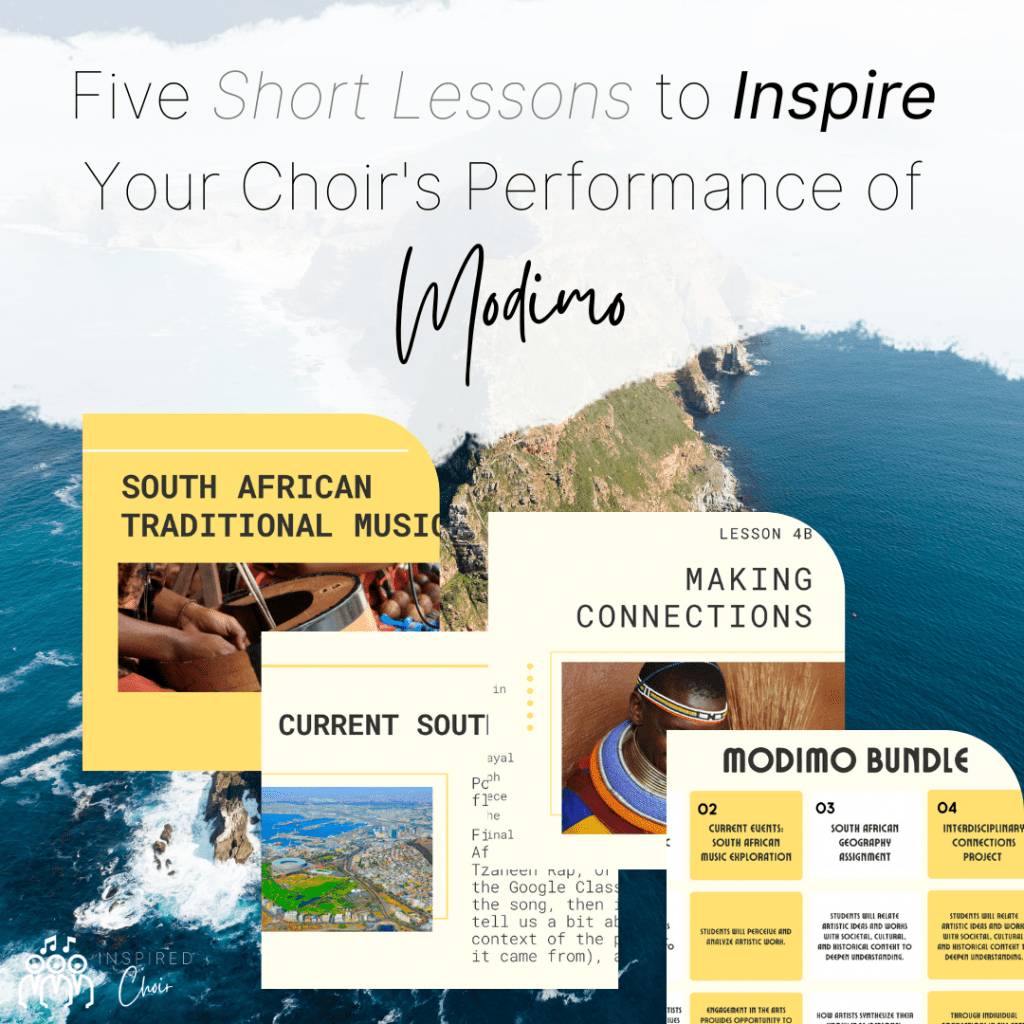
Singing in A Different Language Worksheet
Check out the Inspired Choir Shop for the Singing in A Different Language Worksheet. Utilizing this worksheet, singers will:
- Examine the characteristics of the language in which they are singing
- Consider the ways in which the composer has highlighted the language in their work
- Anticipate challenges of singing in the language
- Interpret the meaning of their piece
- Prepare their score with the appropriate annotations
